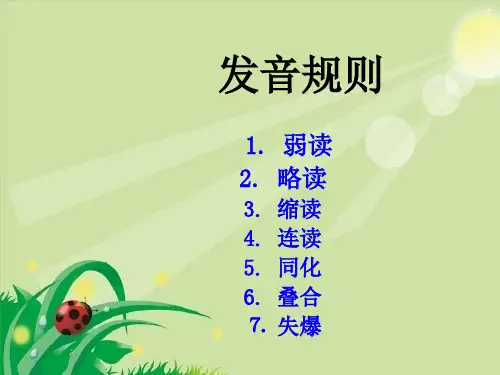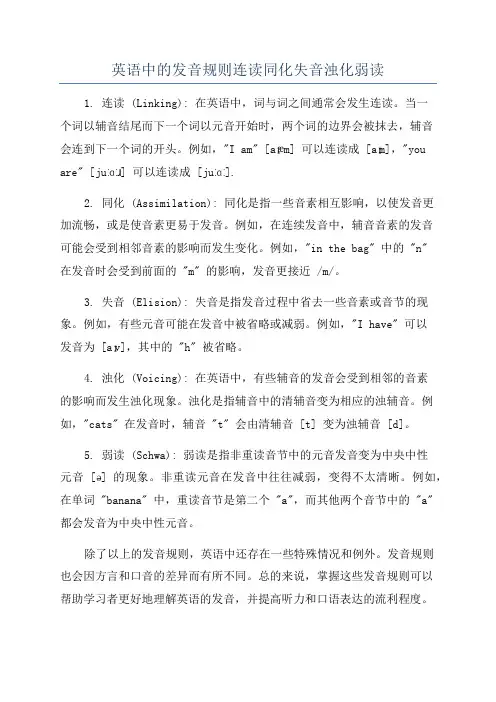英语语音中的同化.ppt
- 格式:pdf
- 大小:2.03 MB
- 文档页数:13


同化英语规则
同化英语规则:
主要是以下三种方式:
1、辅音[d]与[j]相邻时,被同化为[dэ]:Would you....?
2、辅音[t]与[j]相邻时,被同化为[t∫]:Can't you:...?
3、辅音[s]与[j]相邻时, 被同化为[∫]:Miss you
人们在说话的时往往会不自觉地让一个音受相邻音的影响,使它们变得与其相同或相似;或者两个音互相影响,变为第三个音。
这两种现象被称为音的同化。
同化可以发生在同一个词、复合词内或者句子相邻词之间。
音的同化也是一种连读的现象,两个词之间非常平滑的过渡,导致一个音受临音影响而变化。
扩展资料
省音:
在快速、随便的言语中,一些音素被省略掉,被称为省音。
省音能提高语速,使说话省力。
在正式场合和语速慢的情况下,省音不是必须的。
1、同一单词内元音的省略,主要是非重读音节中的[ə]和[ɪ],如:ord(i)n(a)ry。
2、当前一单词以辅音结尾,后一单词以[ə]开头时,[ə]常被省略,如:walk (a)way。
3、当前一单词以否定形式-n't结尾,后一单词以辅音开头时,[t]常被忽略,如:She isn'(t) there.
4、任何一个辅音,若后面紧跟着[h],[h]可以不发音。
如:Come (h)ere!
5、[v]若后面紧跟辅音,[v]可以不发音。
如:gi(ve) me
6、将多个单词利用连读爆破等拼和在一起。
如:gotta(got to),gonna(going to),kinda(kind of),lotsa(lots of)。




浅析英语语音同化现象
英语语音同化现象是指说英语时,语音系统会受到语言环境和说话者本身语言背景的影响,导致语音发音发生变化。
这种变化通常是在音素和音节之间发生,并可能导致听起来不够标准。
最常见的同化现象是音节内同化。
这意味着说话者会在一个音节中使用同一种发音,而不是根据词汇的正确发音进行发音。
例如,说话者可能会将单词“cat”中的元音发音成“kæt”,而不是正确的“kæt”。
另一种常见的同化现象是音素间同化。
这意味着说话者会将不同的音素组合在一起,使其听起来像是同一种音素。
例如,说话者可能会将“th”组合成“f”,而不是正确的“θ”。
还有一种常见的同化现象是语音插入。
这意味着说话者会在不该有的地方插入额外的音素。
例如,说话者可能会在单词“butter”中插入额外的“t”音素,使其听起来像“but-tuh-er”。
同化现象是自然而常见的语言变化过程。
然而,如果说话者希望被听者理解为熟练的英语说话者,那么他们需要努力避免这些现象的发生。
这可以通过练习标准发音和纠正错误来实现。
此外,语音同化现象也可能是说话者学习英语时所遇到的障碍之一。
在这种情况下,他们需要接受语音训练并在练习和规范中加强他们的发音能力。
语音同化现象是英语语音的一个常见现象,但通过练习和纠正可以避免它的发生并提高说话者的语音能力。

英语中的同化assimilationAssimilation of Speech Sounds inEnglish英语中的同化Definition & Theoretical Research Shane (2006):it is a process in which a segment takes on feature of sounds from a neighbouring one.Victoria Fromkin (2004):assimilation is a kind of ease of articulation process in which one sound influences the pronunciation of another adjacent or nearby sound.Ladefoged (2006):anticipatory co-articulation is by far the commonest cause of assimilations in English.Definition & Theoretical ResearchRoach (2001): regressivedefines two kinds of assimilationprogressiveregressive:when the final consonant changes to become like the initial consonant of the second wordprogressive:when the final consonant becomes like the preceding consonant in some way as in voicingDefinition & Theoretical ResearchDai Weidong(2010):A New Concise Course in Linguistics for Students of English“assimilating one sound to anotherby‘copying’a feature of a sequential phoneme, thus making the two phones similar”Hu Zhuanglin (2006):assimilation is a process by which one sound takes on some or all the characteristics of a neighboring soundregressive assimilation:If a following sound is influencing a preceding soundprogressive assimilation:if a preceding sound is influencing a following sound3 TypesDirection Result FeatureDirectionregressive assimilationnewspaper :/njuspeip?//njuzpeip?/progressive assimilationit's :/its/what's : /w ?ts//itz/ /w ?tz/reciprocal/double assimilationdid you : /di ’d ?u//did u/√×termsterm explanationthe assimilated sound/the targetsound that changesthe conditioning sound/the triggersound that causes the changehomorganic sound(同器官发出的,发音部位相同的)two sounds that have the same place of articulationTypes Classified According to Result/doc/7c18074675.html,plete or total assimilation:one phone becomes identical to another phone or two different phones become completely identical.e.g. we t p aint /we p p e?nt/whi te c oat /wa?k k??kt/te n m en /te m m en/goo d b oy /g?b b??/(cited from 李梅.英语语音的同化[J].内蒙古科技与经济,2000(7)2. Partial assimilation:one phone is partly identical to another phone orone phone acquires the same feature (place,manner, voicing, height, rounding, etc.)as another phone.(a) Acquire the feature of place:no t me /n?p mi:/i n bed /?m bed/(b) Voicing assimilation such as third person singularand plural endings –s:pat pat[s] pad pad[z]cup cup[s] cub cub[z](cited from Linguistics --A Course Book by Hu Zhuanglin)types classified according to FeatureFeatureassimilation of place assimilation ofvoiceassimilation ofmannerassimilation of place1.nazalization(鼻音化)eg. cap [k?p] can [k?n] tap [t?p] tan [t?n]lap [l?p] map [m?p] 2.dentalization(齿音化)eg. tent [t?nt] tenth [t?nθ] ninety [na?nti] ninth [na?nθ](cited from Linguistics --A Course Book by Hu zhuanglin)3.velarization(腭音化)alveolar齿龈音+velar软腭音velar软腭音[t,d,n,s.z] + [k,g,?] [k,g,?]eg. since [s?ns] sink [s??k]mince [m?ns] mink [m??k][t] [k] : whi te c oat /wa?k k??kt/; fa t g irl[d] [g]: ba d c old /b?g k??ld/; ba d g irl[n] [?]: o ne c up /w?? k?p/; mai n g ate4.alveolar齿龈音+bilabial双唇音bilabial双唇音[t,d,n,s.z] + [p,b,m,w] [p,b,m,w] eg. [t] [p]: we t p aint /we p p e?nt/; best man /worker[d] [b]: goo d b oy /g?b b??/; old man[n] [m]: go ne p ast /g?m pɑ:st/ ; on me5. palatal process 腭化过程[s,z,t,d]+[j,?] [?,?,?, ?]eg.1. [s] [?]: sugar [?ug?] (s+j=?)has she[h?z ?i?] [hi:]2. [z] [?]: measure[me)where’s yours[we??j?:z]3.[t]+[j] [?]: nature (t+j=?)Glad to meet you! [gl?d tumi:tju:][gl?(d)tu mi:t?u] 4.[d]+[j] [?]: solider['sold??] (d+j= d?)education [,?d?u'ke??n]And you? [?nd ju:] [?n d?u:] cited from PengHuiassimilation of voice1.devoicing清音化: a process by which voiced soundsbecome voiceless[v,f]; [e,θ]; [z,s]; [?,?]; [?, ?] voiced voicelesseg. five past(v→f)[fa?vpɑ?st]→[fa?fpɑ?st] has to (z→s) [h?zt?] →[h?st?]edge to edge (?→?)[ ??t] → [ ??t]2.清清浊浊动词的第三人称单数形式,复数形式以及过去式形式的读音assimilation of manner1.方法同化指原来发音方法不同的相连辅音因相互作用而具有了相同的发音方法。

英语中的发音规则连读同化失音浊化弱读1. 连读 (Linking): 在英语中,词与词之间通常会发生连读。
当一个词以辅音结尾而下一个词以元音开始时,两个词的边界会被抹去,辅音会连到下一个词的开头。
例如,"I am" [aɪæm] 可以连读成 [aɪm],"you are" [juːɑːɹ] 可以连读成 [juːɑː].2. 同化 (Assimilation): 同化是指一些音素相互影响,以使发音更加流畅,或是使音素更易于发音。
例如,在连续发音中,辅音音素的发音可能会受到相邻音素的影响而发生变化。
例如,"in the bag" 中的 "n"在发音时会受到前面的 "m" 的影响,发音更接近 /m/。
3. 失音 (Elision): 失音是指发音过程中省去一些音素或音节的现象。
例如,有些元音可能在发音中被省略或减弱。
例如,"I have" 可以发音为 [aɪv],其中的 "h" 被省略。
4. 浊化 (Voicing): 在英语中,有些辅音的发音会受到相邻的音素的影响而发生浊化现象。
浊化是指辅音中的清辅音变为相应的浊辅音。
例如,"cats" 在发音时,辅音 "t" 会由清辅音 [t] 变为浊辅音 [d]。
5. 弱读 (Schwa): 弱读是指非重读音节中的元音发音变为中央中性元音 [ə] 的现象。
非重读元音在发音中往往减弱,变得不太清晰。
例如,在单词 "banana" 中,重读音节是第二个 "a",而其他两个音节中的 "a" 都会发音为中央中性元音。
除了以上的发音规则,英语中还存在一些特殊情况和例外。
发音规则也会因方言和口音的差异而有所不同。
总的来说,掌握这些发音规则可以帮助学习者更好地理解英语的发音,并提高听力和口语表达的流利程度。

英语同化发音规则(一)英语同化发音规则什么是英语同化发音规则?英语同化发音规则是指在连读和音位组合的情况下,某些音素会在相邻的音位或音段中互相影响,产生相似或相同的发音现象。
带有同化发音规则的常见场景:•词尾辅音影响词首辅音•词首辅音影响词尾辅音•词中辅音影响相邻辅音词尾辅音影响词首辅音当两个单词相连时,第一个单词的词尾辅音会影响到第二个单词的词首辅音。
常见的情况有:•先行词以清辅音结尾,连读时清辅音会转变为浊辅音。
例如:his apple中的/s/发音会变为/z/,读作[hiz ʔæpl]。
•先行词以浊辅音结尾,连读时保持不变。
例如:big house中的/g/保持不变,读作[bɪghaʊs]。
词首辅音影响词尾辅音当两个单词相连时,第二个单词的词首辅音会影响到第一个单词的词尾辅音。
常见的情况有:•后续词的词首辅音与前一个单词的词尾辅音相同。
例如:red dog中的/d/发音会影响到前一个单词red,使得其/d/发音变得更重,读作[re d͡z dɔːg]。
•后续词的词首辅音与前一个单词的词尾辅音相近,但不同。
例如:big cat中的/t/发音会影响到前一个单词big,使得其/g/发音变得更清,读作[biɡ kʰæt]。
词中辅音影响相邻辅音当单词内部相邻的辅音相连时,辅音会相互影响,产生同化发音。
常见的情况有:•辅音连读时,后一个辅音会受到前一个辅音的影响。
例如:handbag中的/d/和/b/连读时,/d/的发音变得更浊,读作[ˈhæmbæɡ]。
•辅音流失时,某些辅音会在发音时被忽略。
例如:post office 中的/t/会在发音中被省略,读作[pəʊst ˈɒfɪs]。
小结英语同化发音规则在连读和音位组合中起到重要的作用,使得发音更加自然流畅。
理解和掌握这些规则有助于提高英语口语水平,更好地理解他人的口语表达。
参考资料: - [英语中的同化发音]( - [美语连读中的同化现象](。


英语中的同化现象Here is an essay on the topic of assimilation in the English language, with a word count exceeding 1000 words, written entirely in English without any additional punctuation marks in the body of the text.The English language is a constantly evolving means of communication, shaped by the diverse cultural influences that have contributed to its development over time. One of the most fascinating aspects of this linguistic evolution is the phenomenon of assimilation, wherein the pronunciation and spelling of words undergo subtle transformations to better align with the natural flow and patterns of the language. This process, while often subtle and gradual, has had a profound impact on the way English is spoken and written, reflecting the dynamic and adaptive nature of this global means of expression.At its core, assimilation in the English language occurs when the sounds or spellings of words are modified to create a more seamless and natural-sounding flow of speech or writing. This can happen in a variety of ways, such as the elision of sounds, the blending of adjacent phonemes, or the simplification of complex letter combinations. These changes are often driven by the desire forefficiency and ease of articulation, as speakers and writers strive to find the most streamlined and effortless way to convey their ideas.One of the most common examples of assimilation in English is the reduction of certain vowel sounds in unstressed syllables. For instance, the word "computer" is often pronounced as "kuhm-pyoo-ter," with the first syllable's vowel sound reduced to a schwa. This phenomenon, known as vowel reduction, is particularly prevalent in function words such as "the," "a," and "to," where the full vowel sound is often replaced by a more neutral schwa. This process helps to create a more fluid and natural-sounding rhythm in speech, as the emphasis shifts to the more stressed syllables.Another form of assimilation in English is the blending of adjacent sounds, known as coarticulation. This occurs when the articulation of one sound is influenced by the articulation of a neighboring sound, resulting in a subtle modification of the original sounds. For example, the word "impossible" is often pronounced as "im-POSS-uh-bul," with the "m" sound blending into the "p" sound to create a "mp" sound. This type of assimilation helps to streamline the flow of speech and can contribute to the development of new, distinct sounds within the language.The simplification of complex letter combinations is another common manifestation of assimilation in English. Words withmultiple consonant clusters or unusual letter combinations may be modified over time to align more closely with the language's dominant patterns. The word "knight," for instance, was once pronounced with a distinct "k" sound, but has since evolved to a silent "k" in modern English, reflecting the tendency to simplify complex spellings. Similarly, the word "comb" has lost its "b" sound, as the spelling has been adapted to match the more common "m" sound.These examples of assimilation in English highlight the dynamic and adaptive nature of the language, as speakers and writers continuously seek to optimize the efficiency and ease of communication. This process is not limited to individual words, however, as it can also be observed at the level of sentence structure and grammatical patterns.One particularly interesting example of assimilation in English syntax is the development of the "gonna" contraction, which represents the blending of the words "going to." This contraction, which is widely used in both spoken and informal written English, reflects the natural tendency of speakers to streamline their language and create more concise expressions. Similarly, the use of "wanna" and "hafta" to represent "want to" and "have to" respectively, demonstrate how assimilation can shape the way we construct our sentences and convey our ideas.The impact of assimilation on the English language extends beyond the realm of pronunciation and spelling, as it can also influence the evolution of grammatical structures and idioms. The rise of the "ain't" contraction, for instance, represents a form of assimilation that has become deeply embedded in certain regional and social dialects of English. While some may view these assimilated forms as "improper" or "incorrect," they are in fact a natural reflection of the language's adaptability and the way it responds to the needs and preferences of its users.Moreover, the process of assimilation in English is not limited to the realm of individual words or phrases. It can also be observed in the way that languages and dialects interact and influence one another, as speakers borrow and adapt elements from various linguistic sources. The incorporation of loanwords from other languages, such as "cafe" from French or "sushi" from Japanese, is a testament to the flexible and inclusive nature of the English language, which readily absorbs and assimilates new linguistic elements to enrich its expressive capabilities.In conclusion, the phenomenon of assimilation in the English language is a testament to the dynamic and adaptive nature of this global means of communication. From the reduction of vowel sounds and the blending of adjacent phonemes to the simplificationof complex letter combinations and the evolution of grammatical structures, assimilation reflects the ongoing effort of speakers and writers to optimize the efficiency and ease of expression. While some may view these changes as a departure from the "standard" or "correct" form of the language, they are in fact a natural and inevitable consequence of the way language evolves to meet the needs and preferences of its users. By understanding and embracing the role of assimilation in the development of English, we can gain a deeper appreciation for the richness and flexibility of this remarkable linguistic system.。
顺同化和逆同化的例子
同化是使不相同的事物逐渐变得相同或相近。
英语语音的同化(assimilation)是指两个不相同或不相似的音相互影响而变成相同或相似的音的过程。
同化现象普遍存在于俚语或方言之中。
它在辅音因素身上更为常见,原因是为了省力或使两个不同的辅音读起来更容易。
同化既可以发生在同一个词或复合词内,也可以发生在句子中相临的两个词之间。
就同化方向而言,同化大致可以分为三种情况:顺同化;逆同化;互相同化。
1.1.1顺同化(也叫前进同化):一个音受前一个音的影响而发生音变叫顺同化。
如:“What's this?”中/iz/就是受到前面一个清辅音//
的影响而同化为/ts/。
1.1.2逆同化(也叫后退同化):一个音受后一个音的影响而发生音变叫逆同化。
如news中的浊辅音/a/,在newspaper中,受到后面清辅音/p/的影响,同化为清辅音/s/。
语流中两个相邻的不同的音,其中一个受到另一个的影响,在某一个或几个特征上变得跟它相同或相近,语音的这种语流中变化就叫同化。
如英语中表示复数的词尾s本应读作[s],但在dogs中因为受到了前面浊音g的读1音的影响,变成浊音[z]。
前举的“棉被”例也属于同化。
同化是协同发音(Coarticulation)的一种,即发音根据相邻音改变,在英语中,这一现象主要影响发音位置的变化。
1、齿龈辅音t, d, n,当他们在单词或音节结尾时,可以选择性的和下一个音节的发音同化。
(1)/n/在/p/, /b/, /m/前,变成/m/。
ten men /ten ‘men/→/tem ‘men/downbeat /’daʊn bi:t/→//’daʊm bi:t/(2)/n/在/k/, /g/前,变成/ŋ/。
fine grade /faɪn ‘greɪd/→/faɪŋ‘greɪd/incredible /ɪn’kredəbl/→/ɪŋ’kredəbl/。
(3)同理d在/p/, /b/, /m/, /k/, /g/前会分别变成/b/, /g/。
red paint /red ‘peɪnt/→/reb ‘peɪnt/admit /əd’mɪt/→/əb’mɪt/bad guys /’bæd gaɪz/→/’bæg gaɪz/(4)/t/音也有可能变成/p/, /k/,但当/t/音后接辅音时,更多的是发成闭锁音(Glottal stop)。
eight boys /eɪt ‘bɔɪz/→/eɪp ‘bɔɪz/,或更常见的/eɪʔ‘bɔɪz/。
(5)有些人也会在/w/音前发生上述同化,因为/w/也是一个唇音(labial-velar)。
(From Macquarie University website)seen Walter/si:n ‘wɔ:ltə/→/si:m ‘wɔ:ltə/(6)齿龈辅音的其他同化现象。
(From Macquarie University website)①/n/在/f/, /v/前,infant /’infənt/→/’iɱfənt/;invite /in’vaɪt/→/iɱ’vaɪt/(注:/ɱ/音是/m/音的变音,如①所述,/n/音一般会同化成/m/音,又由于/m/音在摩擦音/f/, /v/前会变成/ɱ/,所以这里/n/发/ɱ/音。